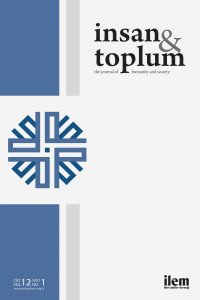Öz
Bu makale, ulus-devlet sınır anlayışının göçmene yönelik hedef ülkedeki toplumsal algı ve tutumları nasıl ve hangi yönlerden etkilediğine ve ulusal cemaatin zihniyetini nasıl şekillendirdiğine odaklanmaktadır. Westfalya Anlaşması’yla kabul edilen ve daha sonraki süreçte tüm dünyaya gittikçe yayılan modern teritoryal sınırlar, devletin imajına ve denetim gücüne işaret eden çok önemli semboller olmuştur. Bunun yanında sınırın, ulusal kimliği, “bizi” ve “öteki”ni, “dostu” ve “düşmanı” tanımlamada da işlevsel bir ideolojik aygıt olduğu belirtilmelidir. Buna bağlı olarak sınır sadece ulus-devlet için değil onun inşa ettiği cemaat için de farklılığa, aidiyete, düzene ve güvene işaret etmekte ve yabancıya, göçmene karşı bir perspektif sunmaktadır. Bu anlamda teritoryal sınır, fiziki anlamda bir yere sabitlenmişken teritoryal sınır fikri, ulusal mekânın ya da daha sosyopolitik bir ifadeyle vatanın hemen her yerinde kendini gösterdiği söylenebilir. Dolayısıyla yerlinin bu “sınır gözlüklü bakış”ına bağlı olarak göçmenler çeşitli kalıp yargılara, damgalama biçimlerine ve ayrımcılıklara maruz kalmaktadırlar. Bu da sınırın sadece sınır bölgesinde değil ulusal teritoryanın her yerinde olabileceğini bize göstermektedir.
Anahtar Kelimeler
Kaynakça
- Ackleson, J. M. (1999). Discourses of identity and territoriality on the US‐Mexico border. Geopolitics, 4(2), 155-179.
- Adıgüzel, Y. (2016). Göç sosyolojisi. Ankara: Nobel Yayınları.
- Allport, G. W. (2016). Önyargının doğası. N. Nirven (Çev.). Sakarya: Sakarya Üniversitesi Yayınları.
- Anderson, M. (1996). Frontiers: Territory and state formation in the modern world. Oxford: Polity Press.
- Aras, R. (2015). Mayın ve kaçakçı. Konya: Çizgi Kitabevi.
Öz
This article focuses on how and in what ways the understanding of the nation-state border affects social perceptions and attitudes towards immigrants in the destination country and how it shapes the mindset of the national community. Modern territorial borders, which were accepted by the Westphalian treaty and then spread to the whole world, became very important symbols pointing to the image and control power of the state. In addition, it should be noted that the border is a functional ideological device in defining national identity, “us” and “other”, “friend” and “enemy”. Accordingly, the border points to difference, belonging, order and trust not only for the nation-state but also for the community it has built, and offers a perspective against foreigners and immigrants. In this sense, it can be said that while the territorial boundary is physically fixed somewhere, the idea of the territorial boundary manifests itself almost everywhere in the national space or homeland. Therefore, immigrants are exposed to various stereotypes, stigmatization and discrimination due to the “border glasses” view of the native. This shows us that the border can be not only in the border region, but in every part of the national territory.
Anahtar Kelimeler
Kaynakça
- Ackleson, J. M. (1999). Discourses of identity and territoriality on the US‐Mexico border. Geopolitics, 4(2), 155-179.
- Adıgüzel, Y. (2016). Göç sosyolojisi. Ankara: Nobel Yayınları.
- Allport, G. W. (2016). Önyargının doğası. N. Nirven (Çev.). Sakarya: Sakarya Üniversitesi Yayınları.
- Anderson, M. (1996). Frontiers: Territory and state formation in the modern world. Oxford: Polity Press.
- Aras, R. (2015). Mayın ve kaçakçı. Konya: Çizgi Kitabevi.
Ayrıntılar
| Birincil Dil | Türkçe |
|---|---|
| Konular | Sosyoloji |
| Bölüm | Araştırma Makaleleri |
| Yazarlar | |
| Yayımlanma Tarihi | 22 Mart 2022 |
| Yayımlandığı Sayı | Yıl 2022 Cilt: 12 Sayı: 1 |


